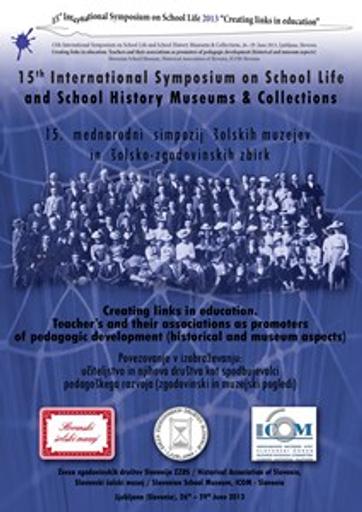/
Dogodki
/
Konference
At the roots of Finnish Teacher Education for Women


To delo avtorja Merja Paksuniemi je ponujeno pod Creative Commons Priznanje avtorstva-Nekomercialno-Brez predelav 4.0 Mednarodna
Datoteke (1)
Opis
The purpose of this research and its presentation is to clarify how the Finnish women teachers were trained in teacher colleges. Usually the lower elementary school teacher training lasted two years in Finland. The main emphasis of this research is on the teacher training college of Tornio, located in Northern Finland. It was the first teacher college located that North. The data was studied from the point of view of History of Education where the source of material provides the answers. The main recourses were archival sources, text books that were used at the college, and other studies. The recourses clarified the students studied many subjects and skills in the college. Such as the didactics and pedagogy, regionalism, religion, math, and health education, and arts including playing and singing, handicrafts, gymnastics, games and sports. Teaching practicum lasted about 3 weeks at a time and took place in the spring semester of the second study year. Teaching practicum was an important phase of studies. According to the recourses Herbart-Zillerism ideology was affecting to the teaching at the teacher training college. It appeared in the textbooks, but other activities as well. The teacher image and it´s requirements were raised from the Finnish societal among the educational ideology. According to the results, Finnish teacher training was considered the seedbed for moral-Christian-nationalist education. Women teachers’ suitability to act as model citizens was carefully assessed already in the student selection. Strict entrance tests started from sending written applications to the college teaching staff. Also it was found that a carefully-selected group of applicants were invited to the second step where the best applicants were selected for the actual entrance test. The students were mainly from the countryside of the Northern Finland, mostly aged 17–26. Finally teachers’ were considered exemplary people for the whole nation and therefore their work was not just seen something one does but adopting certain kind of a role and identity.
Metapodatki (12)
- identifikatorhttps://hdl.handle.net/11686/37705
- naslov
- At the roots of Finnish Teacher Education for Women
- Suomalaisen naisopettajakoulutuksen juurilla
- avtor
- Merja Paksuniemi
- soavtor
- Simonetta Polenghi (mod.)
- predmet
- zgodovina
- šolstvo
- muzej
- history
- school system
- museum
- opis
- The purpose of this research and its presentation is to clarify how the Finnish women teachers were trained in teacher colleges. Usually the lower elementary school teacher training lasted two years in Finland. The main emphasis of this research is on the teacher training college of Tornio, located in Northern Finland. It was the first teacher college located that North. The data was studied from the point of view of History of Education where the source of material provides the answers. The main recourses were archival sources, text books that were used at the college, and other studies. The recourses clarified the students studied many subjects and skills in the college. Such as the didactics and pedagogy, regionalism, religion, math, and health education, and arts including playing and singing, handicrafts, gymnastics, games and sports. Teaching practicum lasted about 3 weeks at a time and took place in the spring semester of the second study year. Teaching practicum was an important phase of studies. According to the recourses Herbart-Zillerism ideology was affecting to the teaching at the teacher training college. It appeared in the textbooks, but other activities as well. The teacher image and it´s requirements were raised from the Finnish societal among the educational ideology. According to the results, Finnish teacher training was considered the seedbed for moral-Christian-nationalist education. Women teachers’ suitability to act as model citizens was carefully assessed already in the student selection. Strict entrance tests started from sending written applications to the college teaching staff. Also it was found that a carefully-selected group of applicants were invited to the second step where the best applicants were selected for the actual entrance test. The students were mainly from the countryside of the Northern Finland, mostly aged 17–26. Finally teachers’ were considered exemplary people for the whole nation and therefore their work was not just seen something one does but adopting certain kind of a role and identity.
- Esityksen tarkoituksena on selventää tutkimusta siitä, miten suomalaisia naisopettajia koulutettiin opettajaseminaareissa. Yleensä opiskelu alakansakoulunopettaja seminaarissa kesti kaksi vuotta. Lähemmän tarkastelun kohteena on Tornion alakansakoulunopettaja seminaari, joka oli Pohjois-Suomen ensimmäinen opettajankoulutuslaitos. Lähdeaineistoa tarkasteltiin kasvatuksen historian tutkimuksen keinoin. Lähdemateriaalina käytettiin arkistolähteitä, opetuksessa käytössä olleita oppikirjoja sekä muita tutkimuksia. Lähteiden mukaan seminaarin opiskelijat opettelivat useita oppiaineita ja taitoja opiskelunsa aikana. Näitä olivat kasvatusoppi, ympäristöoppi, uskonto, matematiikka ja terveysoppi. Lisäksi he opettelivat harmonin soittamista ja laulamista, käsitöitä ja liikunnallisia taitoja. Opetusharjoittelu kesti noin kolme viikkoa toisen opintovuoden keväällä. Tämä oli tärkeä osa opettajaksi kasvamista. Aineisto osoittaa, että herbart-zilleriläisyys vaikutti voimakkaasti seminaarissa annettuun opetukseen. Se näkyi oppikirjojen painotuksissa mutta myös muissa seminaarin toiminnoissa. Tulosten mukaan opettajakuvan vaatimukset kumpusivat suomalaisesta yhteiskunnasta ja kasvatuksellisesta ideologiasta: suomalaista opettajankoulutusta pidettiinkin siveellis-kristillis-isänmaallisena koulutuslaitoksena. Naisopettajien sopivuutta opettajan ammattiin ja myös mallikansalaisena olemiseen punnittiin tarkkaan jo seminaarin pääsykokeissa. Pääsykokeet perustuivat järjestelmään, jossa hakupapereiden perusteella valittiin varsinaisiin pääsykokeisiin. Varsinaisissa pääsykokeissa valittiin opettajaksi sopivin aines. Valituiksi tulleet opiskelijat olivat suurimmaksi osaksi kotoisin Pohjois-Suomesta, iältään enimmäkseen 17–26 - vuotiaita. Opettajat olivat mallikansalaisia ja sitä varten opettajan rooli sekä identiteetti tuli omaksua jo opiskeluvaiheessa.
- založnik
- Slovenski šolski muzej
- Zveza zgodovinskih društev Slovenije
- ICOM Slovenija
- Inštitut za novejšo zgodovino
- datum
- 2013
- 28. 06. 2013
- tip
- video
- dogodek
- jezik
- Angleščina
- jeDelOd
- pravice
- licenca: ccByNcNd
